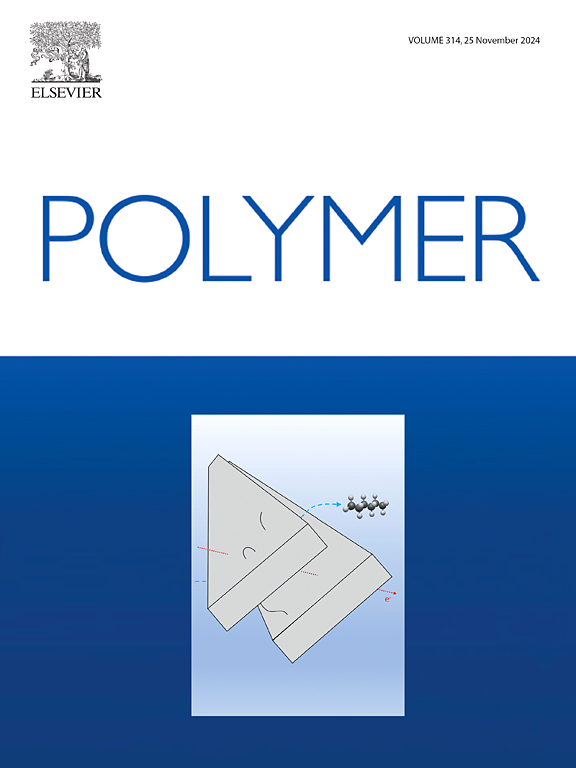聚乙二醇接枝木质素可扩展熔融共混提高聚酰胺6的热氧化稳定性
IF 4.5
2区 化学
Q2 POLYMER SCIENCE
引用次数: 0
摘要
聚酰胺6 (PA6)的热氧化降解对于暴露在高温下的汽车或电气部件来说是一个关键问题。传统的稳定剂通常是有毒的,随着时间的推移会浸出,而天然添加剂如木质素是有前途的替代品,它们往往与聚合物的混溶性低。采用熔融挤压法制备了聚酰胺6 (PA6)和聚乙二醇接枝木质素(GL)共混物,并对其热氧化稳定性进行了评价。GL共混物的力学和热性能与纯PA6相似,但DSC、XRD和IR分析表明木质素通过促进α-相的形成来影响其晶体结构。等温重量分析证实了木质素的抗氧化抑制降解作用。120 ~ 180℃的加速时效导致纯PA6的力学性能急剧下降,但5 ~ 10% GL的共混物在168 h内几乎没有变化,并且采用时间-温度叠加原理构建了主曲线。XRD分析表明,木质素对老化结晶有调节作用,有利于空气中α-相的转变。这些结果表明,GL可以改善PA6的热稳定性,延长其使用寿命,并有利于报废机械回收以及退火等制造工艺。本文章由计算机程序翻译,如有差异,请以英文原文为准。


Enhancing the thermo-oxidative stability of polyamide 6 by scalable melt-blending with PEG-grafted glycol lignin
Thermo-oxidative degradation of polyamide 6 (PA6) is a critical problem for automotive or electrical components that are exposed to elevated temperatures. Conventional stabilizers are often toxic and leach out over time, and while natural additives such as lignin are promising alternatives, they tend to have low miscibility with polymers. In this study, blends of polyamide 6 (PA6) and PEG-grafted glycol lignin (GL) were prepared by melt-extrusion and their thermo-oxidative stability was evaluated. GL blends had mechanical and thermal properties similar to neat PA6, but DSC, XRD, and IR analyses indicated that lignin affects the crystal structure by promoting the formation of α-phase. The antioxidant effect of lignin in suppressing degradation was confirmed by isothermal gravimetric analysis. Accelerated aging between 120 and 180 °C resulted in drastically reduced mechanical properties in neat PA6, but the blends with 5–10 wt% GL showed almost no change up to 168 h and master curves were constructed using the time-temperature superposition principle. XRD analysis revealed that lignin regulates aging-induced crystallization and furthermore favors the transition to α-phase in air. These results demonstrate that GL can be used to improve the thermal stability of PA6 for longer service life and can be beneficial for end-of-life mechanical recycling as well as manufacturing processes such as annealing.
求助全文
通过发布文献求助,成功后即可免费获取论文全文。
去求助
来源期刊

Polymer
化学-高分子科学
CiteScore
7.90
自引率
8.70%
发文量
959
审稿时长
32 days
期刊介绍:
Polymer is an interdisciplinary journal dedicated to publishing innovative and significant advances in Polymer Physics, Chemistry and Technology. We welcome submissions on polymer hybrids, nanocomposites, characterisation and self-assembly. Polymer also publishes work on the technological application of polymers in energy and optoelectronics.
The main scope is covered but not limited to the following core areas:
Polymer Materials
Nanocomposites and hybrid nanomaterials
Polymer blends, films, fibres, networks and porous materials
Physical Characterization
Characterisation, modelling and simulation* of molecular and materials properties in bulk, solution, and thin films
Polymer Engineering
Advanced multiscale processing methods
Polymer Synthesis, Modification and Self-assembly
Including designer polymer architectures, mechanisms and kinetics, and supramolecular polymerization
Technological Applications
Polymers for energy generation and storage
Polymer membranes for separation technology
Polymers for opto- and microelectronics.
 求助内容:
求助内容: 应助结果提醒方式:
应助结果提醒方式:


